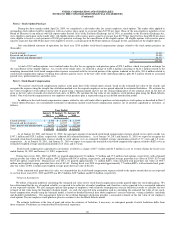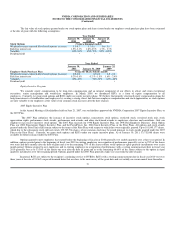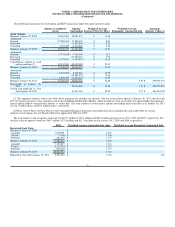NVIDIA 2011 Annual Report Download - page 65
Download and view the complete annual report
Please find page 65 of the 2011 NVIDIA annual report below. You can navigate through the pages in the report by either clicking on the pages listed below, or by using the keyword search tool below to find specific information within the annual report.
NVIDIA CORPORATION AND SUBSIDIARIES
NOTES TO THE CONSOLIDATED FINANCIAL STATEMENTS
Note 1 - Organization and Summary of Significant Accounting Policies
Our Company
NVIDIA Corporation invented the graphics processing unit, or GPU, in 1999. Since then, we have strived to set new standards in visual computing
with interactive graphics available on devices ranging from tablets and smart phones to notebooks and workstations. Our expertise in programmable GPUs
and computer-systems technology has led to breakthroughs in parallel processing which make supercomputing inexpensive and widely accessible. We are
strategically investing in three major areas – visual computing, high performance computing and mobile computing. We serve the visual computing market
with our consumer GeForce graphics products and professional Quadro graphics products; the high performance computing market with our Tesla computing
solutions products; and the mobile computing market with our Tegra system-on-chip products.
We have three financial reporting segments – GPU, Professional Solutions Business, or PSB and Consumer Products Business, or CPB. During
fiscal years 2010 and 2009, we operated and reported four major product-line operating segments: the GPU business, the PSB business, the media and
communications processor, or MCP, business, and the CPB business. However, during the first quarter of fiscal year 2011, we began reporting internally the
results of our former MCP segment along with the results of our GPU segment to reflect the way we manage the GPU business. Comparative periods
presented reflect this change.
Our GPU business is comprised primarily of our GeForce discrete and chipset products which support desktop and notebook personal computers, or
PCs, plus memory products. Our PSB is comprised of our Quadro professional workstation products and other professional graphics products, including our
NVIDIA Tesla high-performance computing products. Our CPB is comprised of our Tegra mobile products which support tablets, smartphones, personal
media players, or PMPs, internet television, automotive navigation, and other similar devices. CPB also includes license, royalty, other revenue and associated
costs related to video game consoles and other digital consumer electronics devices. Original equipment manufacturers, or OEMs, original design
manufacturers, or ODMs, add-in-card manufacturers, system builders and consumer electronics companies worldwide utilize our processors as a core
component of their entertainment, business and professional solutions.
We were incorporated in California in April 1993 and reincorporated in Delaware in April 1998. Our headquarter facilities are in Santa Clara,
California. Our web address is www.nvidia.com. The contents of our website are not a part of this Form 10-K.
All references to “NVIDIA,” “we,” “us,” “our” or the “Company” mean NVIDIA Corporation and its subsidiaries, except where it is made clear
that the term means only the parent company.
Fiscal Year
We operate on a 52 or 53-week year, ending on the last Sunday in January. Fiscal year 2011 was a 52-week year while fiscal year 2010 was 53-
week year and 2009 was a 52-week year.
Reclassifications
Certain prior fiscal year balances have been reclassified to conform to the current fiscal year presentation.
Principles of Consolidation
Our consolidated financial statements include the accounts of NVIDIA Corporation and its wholly-owned subsidiaries. All material intercompany
balances and transactions have been eliminated in consolidation.
Use of Estimates
The preparation of financial statements in conformity with accounting principles generally accepted in the United States of America, or U.S.GAAP,
requires management to make estimates and assumptions that affect the reported amounts of assets and liabilities and disclosures of contingent assets and
liabilities at the date of the financial statements and the reported amounts of revenue and expenses during the reporting period. Actual results could differ from
those estimates. On an on-going basis, we evaluate our estimates, including those related to revenue recognition, cash equivalents and marketable securities,
accounts receivable, inventories, income taxes, goodwill, stock-based compensation, warranty liabilities, litigation, investigation and settlement costs and
other contingencies. These estimates are based on historical facts and various other assumptions that we believe are reasonable.
62
























